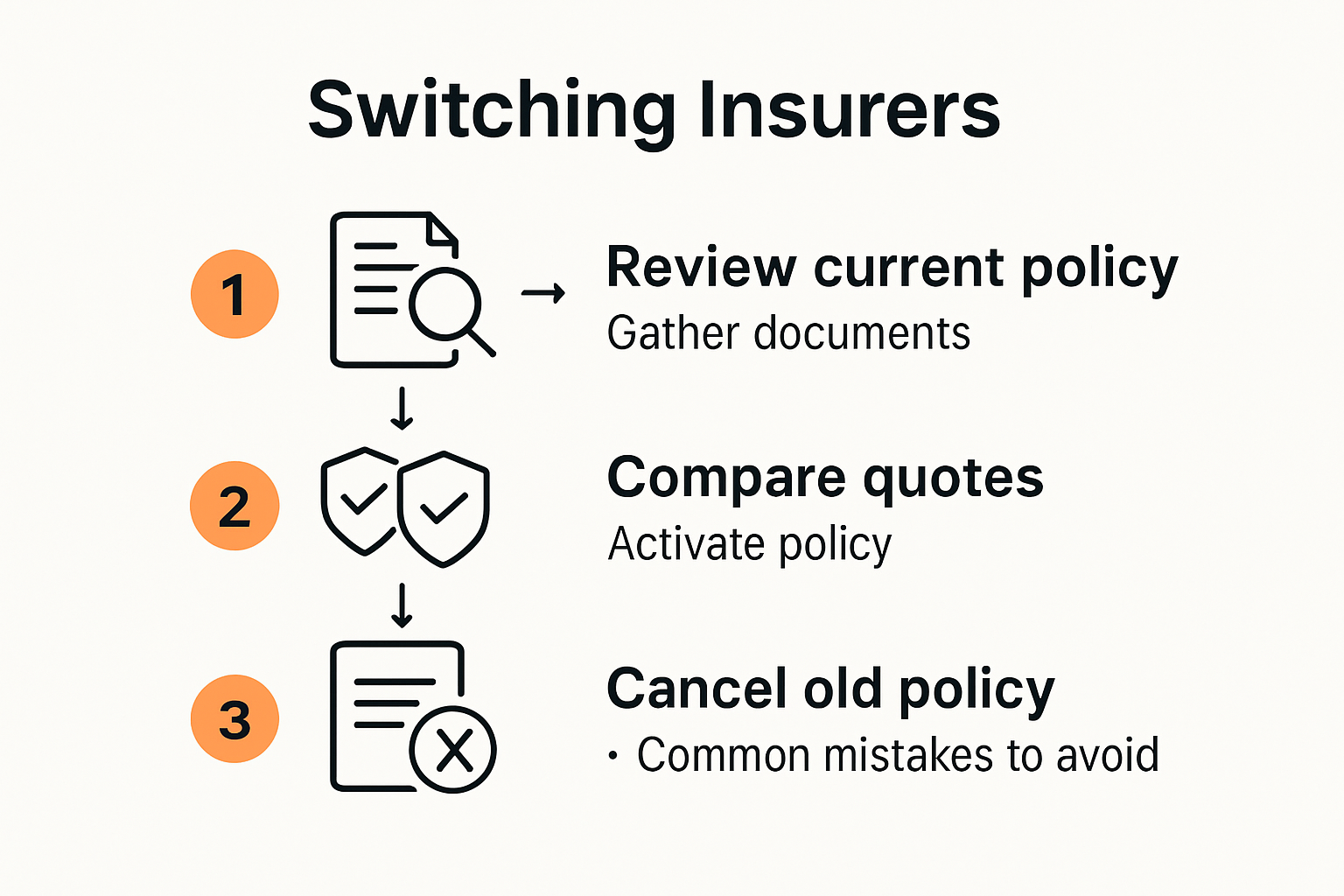
Switching car or home insurers can feel like a big mission, but the savings might shock you. South Africans who compared policies found that over 30 percent managed to lower their annual premiums just by switching providers. Most people stress over cancellation fees or the admin, but here’s a twist. The real money drain often hides in the small print of your old policy, not the switching process. That gap between what you think you’re covered for and what you actually get could cost you plenty more than you expect.
Table of Contents
- Preparing To Switch Your Insurer Easily
- Steps To Move Your Car Or Home Insurance
- Common Mistakes And How To Avoid Them
- Maximising Savings With Your New Policy
Quick Summary
| Takeaway | Explanation |
|---|---|
| Review Your Current Policy | Conduct a thorough review of your existing insurance policy, focusing on coverage details, exclusions, and cancellation terms to avoid unexpected fees during the switch. |
| Compare Multiple Quotes | Obtain quotes from at least three providers, considering coverage extent and additional benefits, not just the premium price, to ensure comprehensive protection. |
| Manage Timing Carefully | Plan your switch before renewal dates or after significant life changes to maximize savings and ensure continuous coverage without gaps. |
| Avoid Common Mistakes | Be vigilant about policy details, financial implications, and documentation processes to prevent coverage gaps and potential financial liabilities during the transition. |
| Leverage Digital Tools | Use online platforms for policy customization and premium adjustments based on actual usage to ensure cost-effective and tailored insurance solutions. |

Preparing to Switch Your Insurer Easily
Switching insurers requires strategic planning and careful preparation to ensure a smooth transition without compromising your coverage or financial protection. While the process might seem daunting, breaking it down into manageable steps can help you navigate the change effectively.
Understanding Your Current Insurance Policy
Before initiating a switch, conduct a thorough review of your existing insurance policy. Check out our guide on insurance fundamentals to understand the critical elements you need to examine. According to research from FastCompany, reviewing your current policy helps you identify:
- Coverage Details: Understand exactly what your current policy protects
- Exclusions: Know what scenarios are not covered
- Cancellation Terms: Identify potential penalties or notice periods for switching
This preliminary investigation prevents unexpected fees and ensures continuous protection during the transition.
Documenting Your Insurance History
Expatica’s comprehensive insurance guide emphasizes the importance of gathering necessary documentation before switching insurers. Compile the following critical documents:
- Vehicle registration papers
- Proof of no claims bonus
- Current policy details
- Property ownership documents
- Recent claim history
Having these documents ready streamlines the application process with new insurers and helps secure more accurate quotes. Insurance providers appreciate thorough and organized applicants who demonstrate proactive risk management.
Timing Your Insurance Switch Strategically
Timing plays a crucial role in how to switch insurers effectively. Research indicates that regularly reviewing and updating your insurance policy ensures you remain adequately protected. Consider switching during these optimal periods:
- Before your current policy renewal date
- When your asset values have significantly changed
- After major life events like marriage, home purchase, or vehicle upgrade
- When you notice substantial premium increases
By strategically timing your switch, you can maximize potential savings and ensure your coverage evolves with your changing life circumstances. Remember, a well-planned insurance transition protects not just your assets but also your financial peace of mind.

Steps to Move Your Car or Home Insurance
Moving your car or home insurance requires a methodical approach to ensure seamless coverage and optimal financial protection. The process involves several critical steps that demand careful attention and strategic planning.
Obtaining and Comparing Multiple Quotes
Imotonews research emphasizes the importance of comprehensive quote comparison before switching insurers. Start by gathering quotes from at least three different insurance providers. When comparing quotes, look beyond just the premium price and consider:
- Coverage Extent: Ensure the new policy matches or exceeds your current protection
- Excess Amounts: Compare the out-of-pocket expenses you would pay in case of a claim
- Additional Benefits: Evaluate extra services like roadside assistance or emergency home repairs
Pro tip: Use online comparison tools to streamline this process and get comprehensive insights quickly. Learn more about reducing insurance costs to make an informed decision.
Securing and Activating Your New Policy
Autogen’s insurance guide recommends a strategic approach to transitioning between insurance providers. Once you have selected your new insurer, follow these crucial steps:
- Request a detailed policy document outlining all terms and conditions
- Confirm the exact activation date of your new insurance coverage
- Ensure there are no gaps between your current and new policy periods
- Verify that all assets (vehicle, home) are correctly listed and covered
Most insurers offer a 30-day cooling-off period, allowing you to cancel if the coverage does not meet your specific needs. This provides an additional layer of protection and flexibility during your insurance transition.
Cancelling Your Existing Insurance Policy
Properly terminating your existing insurance policy is as important as selecting a new one. According to Autogen’s comprehensive guide, follow these recommended steps:
- Contact your current insurer in writing to initiate the cancellation process
- Request a confirmation of cancellation and final settlement statement
- Confirm the exact date your current policy will be terminated
- Ensure your new policy is active before cancelling the existing one
Timing is critical when switching insurers. By carefully managing the transition, you can avoid potential coverage gaps and ensure continuous protection for your valuable assets. Remember that a well-planned insurance switch can potentially save you money while maintaining comprehensive coverage.
Common Mistakes and How to Avoid Them
Switching insurers can be a complex process fraught with potential pitfalls that could compromise your financial protection. Understanding and anticipating these common mistakes can save you significant time, money, and stress during your insurance transition.
Overlooking Policy Details and Exclusions
Milliman’s insurance industry research highlights a critical error many policyholders make: failing to thoroughly examine new policy terms and exclusions. Avoiding this mistake requires meticulous attention to detail:
- Coverage Gaps: Carefully compare your new policy against your previous coverage
- Specific Exclusions: Identify what scenarios are not protected under the new policy
- Fine Print: Read entire policy documents, not just summary pages
Understand the nuances of insurance coverage to ensure you are not caught off guard during a potential claim. Many policyholders discover too late that their new insurance does not provide the same level of protection as their previous policy.
Financial Miscalculations and Hidden Costs
Research from Insurance South Africa reveals that policyholders often underestimate the financial implications of switching insurers. Key areas to scrutinize include:
- Excess Fees: Compare out-of-pocket expenses during claims
- Premium Structures: Understand how premiums might change over time
- Additional Charges: Look for administration fees or cancellation penalties
Don’t be swayed by slightly lower monthly premiums. A seemingly cheaper policy might include higher excess amounts or less comprehensive coverage, ultimately costing you more in the long run.
Procedural and Timing Errors
SATIB’s insurance guide emphasizes the importance of precise procedural steps when switching insurers. Critical errors to avoid include:
- Overlapping or Gaps in Coverage: Ensure seamless transition between policies
- Cancellation Confirmation: Obtain written proof of policy termination
- Documentation Management: Keep comprehensive records of all communications
A single procedural misstep can leave you without insurance protection or result in unexpected financial liabilities. Always maintain clear communication with both your existing and new insurance providers throughout the transition process.
By understanding these common mistakes and taking proactive steps to avoid them, you can navigate your insurance switch with confidence and ensure comprehensive protection for your valuable assets.
Maximising Savings With Your New Policy
Switching insurers presents an excellent opportunity to not only improve your coverage but also reduce your overall insurance expenses. Strategic approaches can help you maximise savings while maintaining comprehensive protection for your valuable assets.
Understanding Policy Valuation Options
FastCompany’s insurance guide highlights the critical importance of selecting the right insurance valuation method. Different valuation options can significantly impact your premiums and potential claim payouts:
- Market Value: Reflects the current resale value of your vehicle
- Retail Value: Based on the dealership selling price
- Agreed Value: A predetermined value negotiated with the insurer
Discover strategies for reducing insurance costs to help you make an informed decision. Carefully evaluating these options can lead to substantial long-term savings.
Leveraging Digital Platforms and Policy Customisation
Milliman’s industry research reveals the growing importance of digital platforms in insurance management. Modern insurance providers offer sophisticated tools that enable precise policy customisation:
- Usage-Based Insurance: Adjust premiums based on actual driving habits
- Flexible Coverage Options: Tailor policies to your specific needs
- Real-Time Policy Adjustments: Modify coverage as your circumstances change
These digital innovations allow for more personalised and cost-effective insurance solutions. By actively engaging with these platforms, you can potentially reduce your premiums while maintaining optimal coverage.
Strategic Approaches to Reducing Premiums
FastCompany’s comprehensive motor insurance guide offers insights into effective premium reduction strategies:
- Regular Policy Reviews: Annually reassess your insurance needs
- Vehicle Security Improvements: Install approved tracking and anti-theft devices
- Bundling Policies: Combine car and home insurance for potential discounts
- Maintaining a Clean Driving Record: Avoid claims to preserve no-claims bonuses
Proactively managing your insurance can yield significant financial benefits. Each step you take to demonstrate lower risk can translate into meaningful premium reductions. Remember that the cheapest policy is not always the most cost-effective in the long run.
By approaching your new insurance policy with a strategic mindset, you can create a win-win scenario that provides comprehensive protection while keeping your financial outlay optimised.
Frequently Asked Questions
How can I save money by switching my car or home insurance?
Switching insurers can potentially save you over 30% on your annual premiums. By comparing multiple quotes and understanding your current policy, you can find better coverage at a lower price.
What should I check before switching my insurance provider?
Before switching, review your existing policy for coverage details, exclusions, and cancellation terms. This helps avoid unexpected fees and ensures that you maintain the right level of protection.
When is the best time to switch my insurance?
The best time to switch your insurance is before your policy renewal date, after major life events (like marriage or a house purchase), or if you notice significant premium increases. Timing your switch can maximize savings and ensure continuous coverage.
What documents do I need to prepare for switching my insurer?
Before switching, gather essential documents such as vehicle registration papers, proof of no claims bonus, current policy details, property ownership documents, and your recent claim history. Having these ready simplifies the application process with a new insurer.
Ready for an Easier Insurance Switch and Bigger Savings?
Feeling lost in the admin of switching insurers or dreading hidden fees? You are not alone. Many South Africans worry about losing out on cover, missing key exclusions, or paying more than they should. This article showed that even the smallest gap in your policy can cost you big. But what if changing your insurance was as rewarding as it was simple?
Let your next move be to secure peace of mind and real value. Take control by comparing trusted options tailored to South Africans just like you. Head to King Price Insurance today to find car, home, and even cellphone cover that fits your life and your budget. Why wait? Make 2025 the year you stop overpaying and start winning at insurance. Click now to see how you can get covered in minutes and save where it matters most.



8 Responses